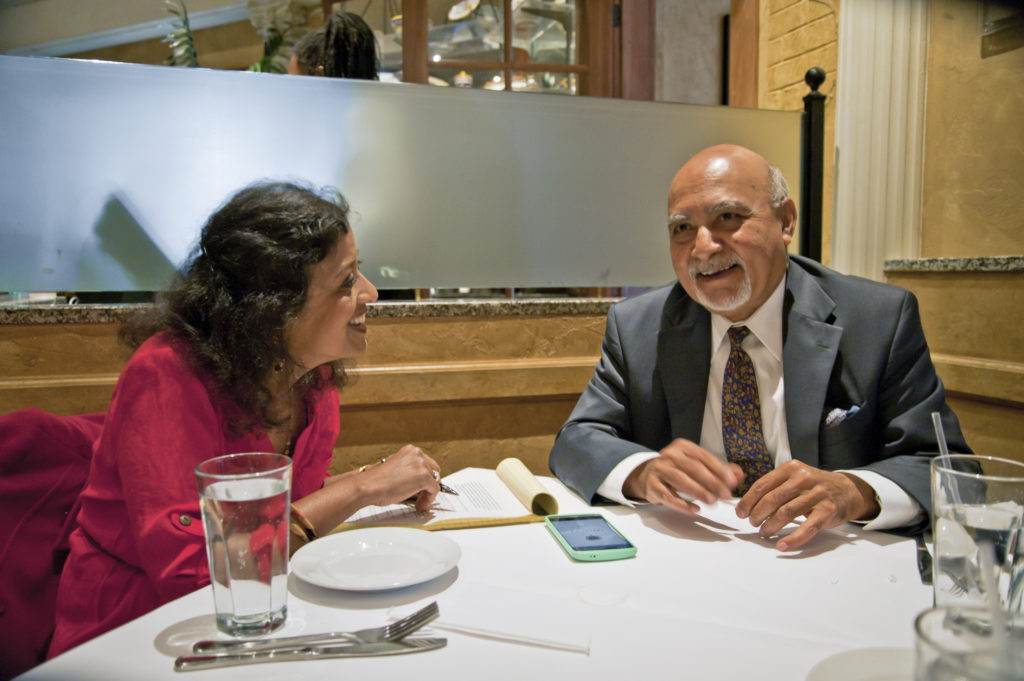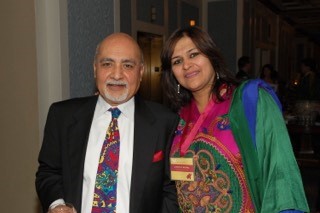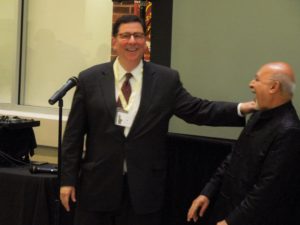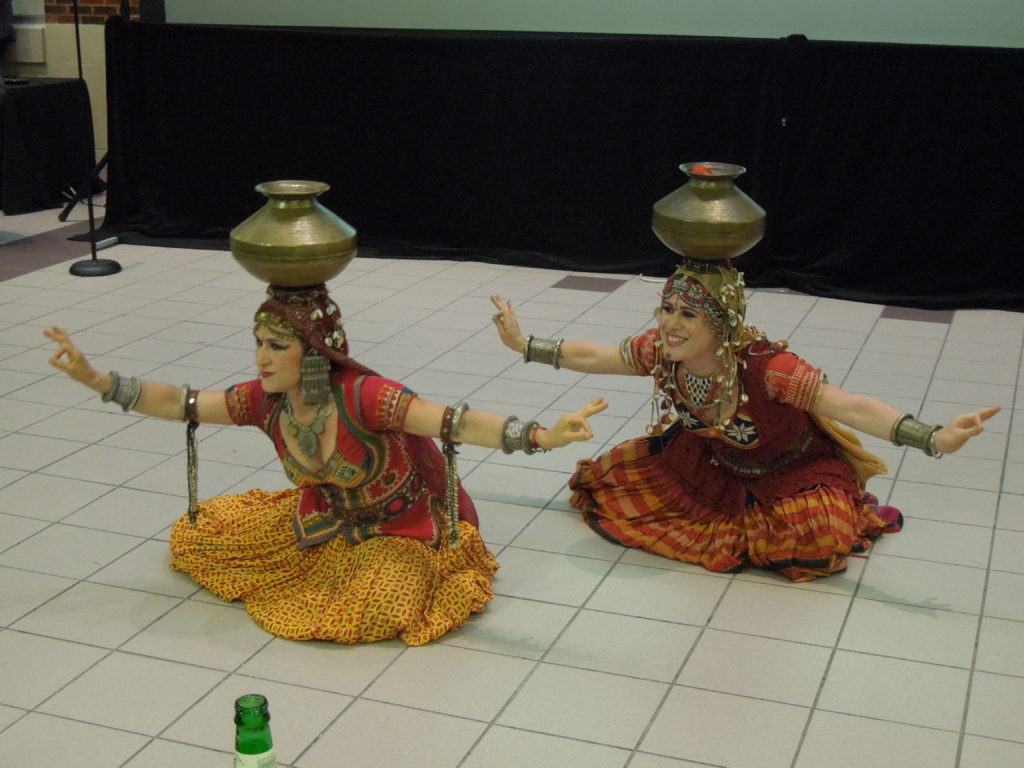By Nandini Mandal, Pittsburgh, PA
e-mail:Â rinkoo1970@gmail.com
The Silk Screen Film Festival completes ten years this year. Nandini Mandal of the Nandanik Dance Academy talked to Harish Saluja, the dynamo behind the festival, on his exciting and sometime exhausting roller coaster journey in these ten years. The freewheeling interactions took place over dinner at the Bravo Cucina in the Galleria in South Hills in May.

Nandini Mandal talking to Harish Saluja over dinner for the interview. Graphics: Â Alisa Jaconson of Silk Screen Asian Arts.
A young engineering student from IIT Kharagpur biked all the way to the suburbs of Kharagpur to watch Satyajit Ray’s Bengali movie Teen Konya (Three Women). Ray’s movies, unlike popular Hindi potboilers of that era, did not have the hero or the heroine break out into song or dance every half hour or melodramatic endings; nor did they have the gloss and glamour associated with the Bombay film industry, before it became Bollywood. Termed a pioneer in the parallel film industry, Ray’s movies were often considered “Art Films,†winning awards and accolades all over the world, but not always at the box office.
The young engineering student returned to his hostel that night — and to his surprise, found himself drawn towards the same theater the next day, and the next. There was something about that genre of storytelling that drew him back to the South Institute Theater at Kharagpur, and also drove him to learn Bengali so as to understand the nuances of the movies better. It also was the beginning of a new madness for him — Movies. He dreamt of making movies one day. And he did.

Harish with Sumedha Nagpal, a volunteer with Silk Screen.
That was Harish Saluja, as most of us know him in the greater Pittsburgh region, who also has been running the Music of India radio program with his friend Vijay Bahl for over 30 years now. Saluja loves films, and anything associated with the movie business. It was this ardent passion for films that has given Pittsburgh, and Western PA, The Silk Screen Film Festival, showcasing Asian and Asian-American films from around the world.
As the Silk Screen Festival celebrates its tenth year this year, The Pittsburgh Patrika, wanted to have a candid conversation with the man-behind-the lens — Saluja himself — about his journey in pursuing his passion from conceptualization to its realization, and the future of the festival in the years ahead.
In his usual casual, yet lively and vivacious style, which is natural to him, Saluja led us down his memory lane, starting with What was it that triggered the idea of hosting a film festival?
When he arrived in the USA in the early nineteen-seventies, like most of his generation, he was often surprised that there was so much ignorance about India and Asia among people in the American mainstream. In disbelief, he recalls, “It remained unchanged for a very long time. Among those in the US mainstream, hardly anyone knew about Tyagaraja, Tagore, Nehru, or Ray. There was a dearth of information about the rich cultural heritage of the Indian subcontinent.â€

Pittsburgh’s Mayor Bill Peduto cracking a Joke with Harish Saluja.
Saluja remembers how his parents would define and differentiate artists from each other: “I remember my father telling me once, ‘Getting a salary, paying bills, building a house are all equivalent to brushing one’s teeth — nothing out of this world. Everyone has to do it. But giving something to society is different.’
“I remember how my mother would get excited when an artist – whether it was a poet, or a singer, or an instrumentalist visited our house. She kept no stones unturned to ensure that her special guests received the best treatment; and that her son — that’s me — recited his best poem before the guests. And all because they were artists who contribute more than others to the world.â€
Harish, an engineer by profession, and an artist and a musician by hobby, entered into filmmaking out of passion. In retrospect, Harish now thinks, one of his American friends unknowingly started the ball rolling. She told him, “Harish, you know art, you know music, you love films. Why don’t you start something that will help promote your culture to the western world?â€
He had also understood that although Pittsburgh was modern culturally, the city had failed to embrace new immigrants, mostly from Asia. He then quoted Richard Florida who authored Rise of the Creative Class: “People go to places where their lifestyle would be valued.â€
Harish ruefully told me, “There is a Columbus Day parade in Pittsburgh, but there is no Chinese New Year celebration, and the city does not celebrate India Day.â€

Sally Wiggins, the anchor at WTAE has been supporting Silk Screen as the emcee of the gala.
Then 9/11 happened. Soon there were incidents of mistaken identity — murders of innocent Sikhs who were shot mistaken for Muslims because of their beards and turbans, when, ironically, most Muslims in the US neither wear turbans nor have beards. This goaded him to do something that could make mainstreamers understand Asia and Asians a little better. Having a film background made it an easy decision for him.
He told himself, “It has to be a film festival.†Thus was born The Silk Screen Asian American Film Festival. The name is a play on the phrases silver screen and silk route — defining the genre of movies to be shown at the festival.
When Harish approached Ed Rendell, then governor of Pennsylvania, he got $15,000 in seed money to help start the festival. He continues: “Various foundations, when approached, were very generous. The first festival targeted 500 people to come to the festival. But we were overwhelmed when over 2000 filmgoers came. It was a smashing success, and a great start. There were recognitions and mention internationally. From there, it was no looking back.â€
Saluja and his board of directors, advisors and team of dedicated volunteers decided to expand the festival so that it reached more people in the greater Pittsburgh area itself. It occurred to them that it helped improve the cultural tourism of Pittsburgh and helped bring in the money from the Governor. (This money has since stopped.)
A team of 30 to 40 volunteers from all backgrounds work hard to make the festival a success right from the red carpet gala night to sellin
g tickets. “We were invited by schools, colleges, and museums as this was a great way of showcasing Asian culture and diversity,†he said, and continued: “It was a good medium to educate children about Asian American culture. Then, in association with a few jazz musical geniuses, we formed the Silk Band that had played at the festival in recent years.†As an aside, Harish gleefully mentioned that the Silk Band was invited to play at Peduto’s Mayoral inaugural.
Harish continues: “Collecting funds to bring and showcase films at theaters, host the directors and actors is a Himalayan task. So financially, the road has not been very smooth in the ten years. To give you some idea, typically, 25% of the funds come from foundations, 50% from corporate sponsors. Only the remaining 25% is from individual donations and ticket sales.â€

Live performances at the gala.
There have been all types of constraints all along. Changing times and the ups and downs in the economy are making it more difficult for Harish and his team. But the financial constraint is a big one. Says Harish, “The foundations have all cut back on their funding, and the governor’s fund has dried up altogether. The foundations who helped enthusiastically to start the festival, now expect the Festival to become financially self-sustaining.â€
Understandably, with the professional and economic success of Asians in the region getting wide coverage in the media, the big-name donors also expect the festival to get more financial support from the Asian community in Pittsburgh.
Harish does not hide his disappointments: “However, Asian communities have provided very little support for the festival in general. Indians, Chinese, Koreans, Middle-Eastern communities and organizations have not come forward so far to help and financially support and promote the festival, despite the festival showcasing again and again films from Iran, India, Pakistan, Turkey, South Korea, Japan, China, and Malaysia among many other Asian countries. Why is this so? That is something for all Asians to ponder.â€
That Pittsburgh is not a glitzy city compared to Cannes, Venice, Toronto, Singapore, London, Chicago, New York, LA, San Francisco, or Miami, also does not help Harish. He contritely says, “We are not able to attract even tourists to Pittsburgh, nationally or internationally despite the picturesque cityscape surrounded by meandering rivers and hills and countless bridges.â€

One of the many live performances at the gala.
Understandably, film makers would rather take their creations to festivals that offer awards and award money than come to a city merely to present their movies. Many of his fellow film makers and friends based in London or India say, “Look, we like you, but what would you do if you had a chance to go to a famous festival?†Most film makers want to go to a big-name festival, win an award, get publicity, sell the film, and move on.
The other huge challenge plaguing the festival that outsiders never realize is the rampant piracy of movies in the Indian subcontinent. “Why would one pay to go to a movie that can be seen for free on YouTube or Einthusan on the day of the release?†Harish rhetorically asks.
Amidst these many challenges, the festival is completing its tenth year. Where does Saluja plan to go from here? He is emphatic: “I would like to see more panel discussions or Q&A sessions with actors and directors. The Festival is moving to September this year from its May schedule so that more university students can participate and add verve and energy. This year, films will be showcased at multiple venues across the city — at Regent Square, the Carnegie Museum, the Water Works Mall, the University of Pittsburgh and Carnegie Mellon University.â€
As our freewheeling exchanges winded down, Saluja sounded optimistic: “The festival has evolved into a Pittsburgh tradition and will continue for years to come. The silver screen that takes the audience on a journey through the Silk Route will continue to enthrall thousands.â€
Join The Patrika in congratulating Harish Saluja and his fantastic team on their decade-long journey on this timeless Silk Route, and wishing him many more of these annual gala.
So, come September, “Lights, Camera, Action,†for the festival.   ♣
